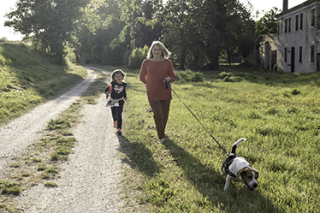Tick-borne Illness and School-Aged Children
Explore Other Kids and Climate Health Impacts
Find information on how climate change can affect tick-borne illnesses and children’s health. Start by reading the fictional story of a school-aged child who is affected by a tick exposure, and learn how similar situations can affect kids across the country. Also get tools to help families prepare and cope with these outcomes from climate change. Finally, check out the regional spotlight.
Taylor's Story
A 7-year-old named Taylor goes on daily nature walks with his grandmother and their dog, Rover. Taylor and Rover often play in a grassy area along their route. Taylor’s grandmother always reminds him to check for ticks after their walks, but one day she finds a red circle on Taylor’s arm. A few weeks later they find out that Taylor has Lyme disease, a serious illness, from being bitten by a tick.

Climate Change Impacts
- Tick-borne diseases, such as Lyme disease, have steadily increased over the last 20 years due to multiple factors, including climate change.1
- Climate change has extended the season of tick activity, and the habitat range of the species of tick that carries tick-borne diseases, which means there are more opportunities for human exposure and disease transmission.
Impacts on Children’s Health
- Children tend to spend more time outdoors than adults, increasing their exposure to ticks. They also rely on others to check for ticks after time outdoors.
- Many tick-borne diseases can have similar signs and symptoms like fever, headache, fatigue, and distinctive skin rashes (e.g., Lyme disease can cause a rash that appears in a red circle like a bull's eye).
- While the majority of children recover from Lyme disease following treatment, some experience long-term symptoms including juvenile arthritis, swelling of the heart tissue (endocarditis), fatigue, or difficulty thinking.
What can I do?
- DO apply an EPA-registered insect repellent labeled for use against ticks. Learn more about preventing tick bites. EPA offers a tool for finding the right EPA-registered insect repellent for your needs.
- DO read all labels on insect repellents to understand proper use, including how much to apply and how often to reapply. When applying to the face, spray on your hands and then carefully apply to your child’s face, avoiding eyes and mouth. Learn more about proper application.
- If you are concerned about using insect repellents on your children, DO consult a healthcare provider for advice, or contact the National Pesticide Information Center (NPIC) on their website or by calling the toll-free number 1-800-858-7378.
- DO check clothing and skin for ticks after spending time outside. Check pets for ticks, as ticks can ride into the home on pets and later attach to a person. If you find a tick on your child’s skin, remove it as soon as possible with a tick removal device or a set of fine-tipped tweezers and dispose of it properly. Learn more about what to do after a tick bite. You can use the CDC’s Tick Bite Bot for assistance in removing ticks and seeking health care.
- DO use caution when removing ticks to ensure that all parts of the insect are removed. Learn how to properly remove a tick.
- DO shower within 2 hours of being outdoors. DO wash your child’s treated skin and clothes with soap and water or bathe when you return indoors.
- DO seek medical attention if you or your child develops a fever or rash within several weeks of a tick bite.
- DO avoid areas where ticks are most common, like wooded and brushy areas, areas with high grass, and leaf litter. When in the woods, stay at the center of marked trails.
- DO note the kind of tick present and monitor any symptoms. Learn more about identifying types of ticks.
What should I not do?
- DON'T use products containing oil of lemon eucalyptus or para-menthane-diol (PMD) on children under the age of three. Learn more about choosing an insect repellent for your child.
- DON'T apply insect repellant under clothing, near food, over cuts, wounds, or irritated skin, or near the eyes and mouth.
- DON'T spray insect repellents in enclosed spaces.
- DON'T allow children to handle insect repellant or apply it to themselves.
The Northeast includes Connecticut, Delaware, District of Columbia, Maine, Maryland, Massachusetts, New Hampshire, New Jersey, New York, Pennsylvania, Rhode Island, Vermont, and West Virginia.
- As the Northeast warms, the range of the kind of ticks that carry tick-borne diseases, including Lyme disease, increases. Because of this, Lyme disease in the Northeast is projected to become more prevalent in the future.2
